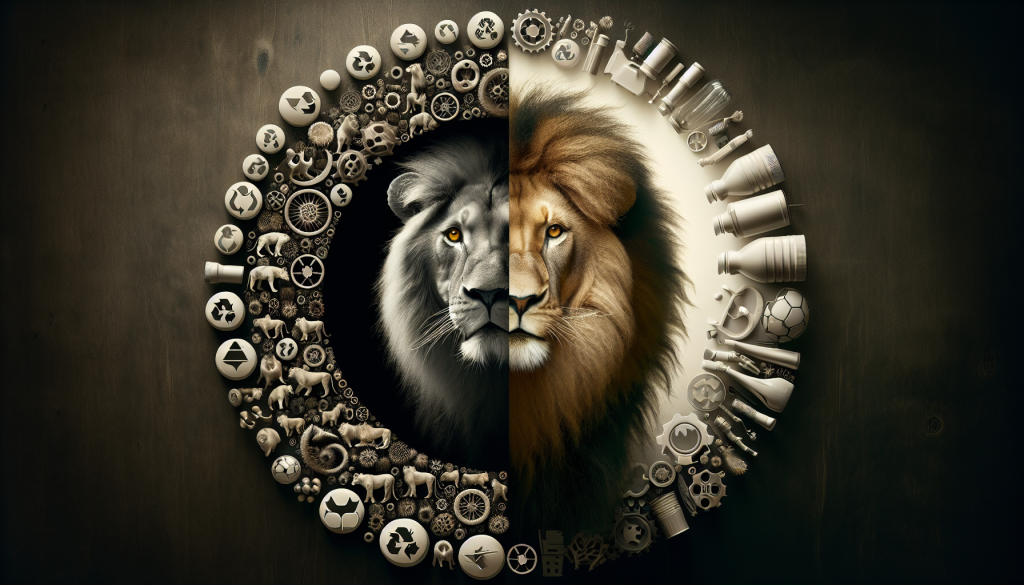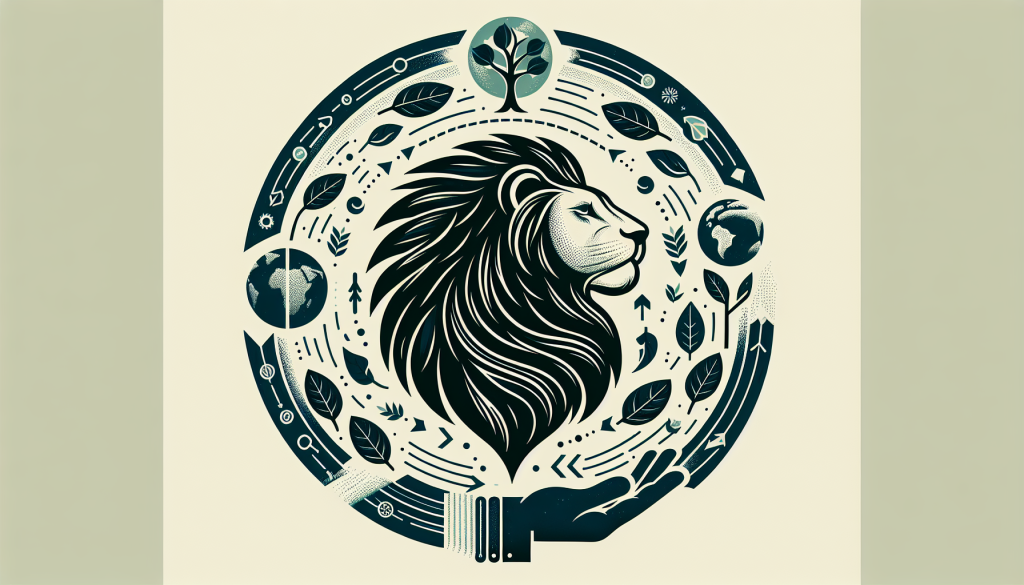So you’ve heard about the Sustainable Development Goals (SDGs), but did you know that lion conservation plays a crucial role in achieving them? Lions, the majestic kings of the savannah, are not only a symbol of power and beauty, but they also contribute to the interconnected web of life on our planet. In this article, we’ll explore how lion conservation efforts align with the SDGs, and why protecting these iconic creatures is not only a matter of conservation, but also sustainable development. Get ready to discover the vital link between lions and our global goals!
The Importance of Lion Conservation
Lions are not just majestic creatures that roam the savannas of Africa, they play a vital role in maintaining the balance of ecosystems. As apex predators, lions help regulate herbivore populations by preying on the weak and sick, thus preventing overgrazing and promoting healthy vegetation growth. By doing so, lions indirectly contribute to the well-being of other animals living in these habitats. Their presence ensures not only the survival of various species but also the overall health and resilience of the entire ecosystem.
However, the lion populations across Africa are facing severe threats, pushing them to the brink of extinction. Habitat loss due to expanding human settlements and agricultural activities is one of the primary causes of their declining numbers. As more land is converted for human use, lions are losing their natural habitat and access to prey. Additionally, the illegal wildlife trade poses a significant risk to lions, with their body parts being sought after for traditional medicine and as trophies. Simultaneously, conflicts between humans and lions are escalating as both populations compete for space and resources.
Beyond their ecological significance, lions hold great cultural and historical value for many communities around the world. For centuries, lions have been a symbol of power, majesty, and strength in various cultures. They have appeared in mythology, folklore, and even on national flags. The conservation of lions is not just about preserving biodiversity; it is also about protecting our collective cultural heritage.

Sustainable Development Goals for Lion Conservation
To address these critical issues and ensure the survival and well-being of lions, several Sustainable Development Goals (SDGs) have been identified. These goals, formulated by the United Nations, aim to guide international efforts towards sustainable development and environmental conservation. By aligning lion conservation with these goals, we can create a comprehensive and holistic approach to protect these iconic animals.
Goal 1: No Poverty
Lion conservation indirectly contributes to eradicating poverty by promoting sustainable tourism and livelihoods for local communities. Safeguarding lion habitats and establishing nature reserves can attract tourists, which, in turn, generates income for the communities living in these areas. This revenue can be used to improve living standards, healthcare facilities, education, and other essential services, lifting individuals and families out of poverty.
Goal 2: Zero Hunger
Preserving lion habitats also ensures the protection of herbivore populations. This, in turn, helps to maintain a healthy balance in ecosystems and prevents overgrazing, which could lead to food scarcity for both wildlife and humans. By conserving lions, we contribute to securing the food sources and livelihoods of local communities, ultimately working towards achieving zero hunger.
Goal 3: Good Health and Well-being
Lions are an integral part of the ecosystem’s overall health. By safeguarding their populations and habitats, we support the well-being of other species, including humans. Healthy ecosystems provide clean air, water, and diverse food sources, promoting good health and well-being for all living beings. Additionally, a thriving lion population contributes to biodiversity conservation, which is essential for maintaining ecological balance.
Goal 4: Quality Education
Lion conservation offers an opportunity to educate and raise awareness among local communities and the global population. By integrating lion conservation into educational curricula and outreach programs, we can instill a sense of responsibility, empathy, and environmental stewardship among future generations. A well-informed society is more likely to value and actively participate in conservation efforts, ensuring a sustainable future for lions and other threatened species.
Goal 5: Gender Equality
Efforts towards lion conservation can also promote gender equality by empowering women in local communities. Women often play a crucial role in natural resource management, and their involvement in conservation initiatives can lead to increased decision-making power, economic opportunities, and social empowerment. By recognizing and promoting gender equality within lion conservation programs, we can achieve a more inclusive and equitable society.
Goal 6: Clean Water and Sanitation
Preserving lion habitats also safeguards water sources and maintains water quality. Lions, as top predators, regulate herbivore populations, preventing overgrazing and soil erosion. This, in turn, helps maintain the quality of freshwater sources, ensuring access to clean water for both wildlife and local communities. Integrating lion conservation with efforts to improve clean water and sanitation can create a more sustainable and resilient environment for all.
Goal 7: Affordable and Clean Energy
Lion conservation contributes to the development of sustainable tourism practices, which can be powered by affordable and clean energy sources. By embracing renewable energy solutions in tourism infrastructure, such as solar panels or wind turbines, we can minimize negative impacts on the environment and reduce our carbon footprint. This not only facilitates the conservation of lions but also supports the achievement of sustainable energy goals.
Goal 8: Decent Work and Economic Growth
Local communities can benefit from lion conservation through job creation and economic growth. Sustainable tourism practices can create employment opportunities such as tour guides, park rangers, conservation educators, and wildlife researchers. By investing in these sectors and promoting responsible tourism practices, we can foster decent work and economic growth while simultaneously conserving lions and their habitats.
Goal 9: Industry, Innovation, and Infrastructure
Lion conservation requires the development and implementation of innovative techniques and technologies to mitigate human-lion conflicts and safeguard their habitats. Collaborations between conservation organizations, researchers, and local communities can lead to the creation of innovative solutions, such as community-based early warning systems, predator-friendly livestock management practices, and the use of drones for monitoring and research. Through these efforts, we can promote sustainable industry, foster innovation, and develop resilient infrastructure while protecting lions.
Goal 10: Reduced Inequalities
Lion conservation can also contribute to reducing inequalities by engaging and involving marginalized communities in decision-making processes. It is essential to ensure that the benefits of conservation and sustainable development reach all segments of society, particularly those who might have been historically marginalized or excluded. By focusing on inclusivity, we can create a more equitable world where everyone has a stake in lion conservation.
Goal 11: Sustainable Cities and Communities
Sustainable lion conservation involves maintaining intact ecosystems and preserving wildlife corridors across landscapes. This requires the integration of conservation efforts into urban planning and development processes. By recognizing the importance of wildlife habitats and connectivity, we can create sustainable cities and communities that coexist harmoniously with wildlife, ensuring the long-term survival of lions and other species.
Goal 12: Responsible Consumption and Production
Lion conservation necessitates responsible consumption and production practices. It involves addressing the demand for illegal wildlife products, such as lion bones or trophy hunting, by raising awareness and implementing stricter regulations and penalties. Encouraging sustainable tourism, supporting local communities in adopting sustainable agricultural practices, and promoting eco-friendly alternatives contribute to responsible consumption and production, creating a more sustainable future.
Goal 13: Climate Action
Preserving lion populations and their habitats also contributes to climate action. Lions play a vital role in regulating herbivore populations, which in turn helps maintain healthy vegetation cover. Healthy ecosystems act as carbon sinks, absorbing and storing carbon dioxide, a greenhouse gas responsible for climate change. By protecting lions and their habitats, we contribute to climate mitigation efforts, ensuring a more sustainable and resilient future.
Goal 14: Life Below Water
Although lions are terrestrial creatures, their conservation indirectly impacts marine ecosystems. By maintaining a healthy balance in terrestrial ecosystems, we contribute to the overall health of watersheds and rivers that ultimately flow into the oceans. By protecting lions, we safeguard the integrity of aquatic ecosystems and ensure the well-being of marine species, promoting life below water.
Goal 15: Life on Land
The conservation of lions aligns directly with Goal 15, as it focuses on protecting and restoring terrestrial ecosystems. Lions play a critical role in maintaining the balance and biodiversity of these ecosystems, making their conservation crucial for achieving this goal. By safeguarding lions and the habitats they depend on, we contribute to the preservation of life on land and the sustainable use of terrestrial resources.
Goal 16: Peace, Justice, and Strong Institutions
Efforts towards lion conservation can also contribute to peace, justice, and strong institutions. Addressing human-wildlife conflicts requires the involvement of local communities in decision-making processes and the establishment of fair and effective conflict resolution mechanisms. By ensuring that both human and wildlife interests are taken into account, we can promote peaceful coexistence, justice, and the development of strong institutions that protect both communities and lions.
Goal 17: Partnerships for the Goals
Lastly, the achievement of lion conservation goals depends on fostering partnerships among various stakeholders. Collaboration between governments, non-governmental organizations, local communities, and the tourism industry is crucial for effective conservation strategies and sustainable development. By building partnerships and working together towards the common goal of lion conservation, we can maximize our impact and create lasting change for these iconic creatures.
In conclusion, the conservation of lions is not only vital for the health of ecosystems but also for the preservation of our cultural heritage. By aligning lion conservation efforts with the Sustainable Development Goals, we can address a wide range of pressing global issues, from poverty and hunger to gender inequality and climate change. By protecting lions and their habitats, we are not only safeguarding a majestic species but also contributing to a more sustainable and resilient future for all.


